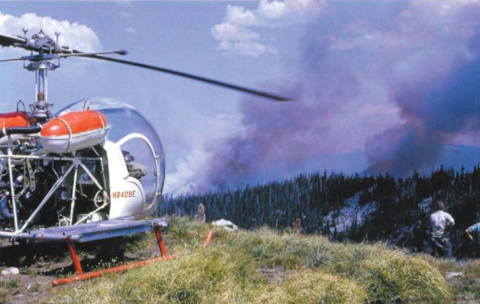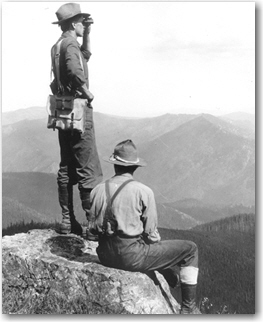
(This article was first published at FireAviation.com)
Twelve years after 13 smokejumpers were killed on the Mann Gulch Fire 13 miles north-northwest of Helena, Montana, 20 jumpers were entrapped on a fire in northern Idaho 83 miles southwest of Missoula, Montana.
It happened August 4, 1961 on the Higgins Ridge Fire in the Nez Perce National Forest after an eight-man crew from Grangeville, Idaho had jumped in the area, followed by 12 men from the Missoula jumper base, the last arriving at 1 p.m. The fire behavior on the two-acre fire was fairly benign until a passing cold front brought a sudden increase in the wind at 4:15 p.m. which resulted in the fire spreading rapidly. The 20 men took refuge in a previously burned area. As the wind increased to 50 mph the supervisors of the two squads, Dave Perry and Fred “Fritz” Wolfrum, instructed the firefighters to remain calm and to clear an area for themselves in the ashes.
Lightning was bursting from the pyrocumulus cloud over the fire as the men in their newly issued orange fire shirts covered their heads with their arms when the fire burned around them. They helped each other swat out the flames on their clothes during the ember shower.
They did not hear it because of the roar of the fire, but they looked up and saw the red skids of a helicopter. It was a Bell 47B-3 that had seating for three people abreast, with the pilot in the middle.
Below is an excerpt from the April, 1994 edition of “The Static Line” published by the National Smokejumper Association:
…The pilot was Rod Snider of the Johnson Flying Service and he had spotted the men and their orange [fire shirts].
Fritz and Snider quickly organized an evacuation plan. Snider had to drop down vertically and take off the same way because of old snags surrounding the jumpers [a maneuver that requires more power than departing from a ridge]. On the first few trips Rod took out two jumpers on each run, having them ride in the cabin. Then, with the helicopter getting hotter, Rod told them he would take four out on each trip. Two rode in the cabin and two hung on to the [cargo trays]. Rod was able to ferry all 20 jumpers to the Freeman Ridge fire camp. Fritz and Tom were among those on the last trip out.
Some of the jumpers were treated at St. Patricks’s Hospital for smoke-burned eyes. Within several days most of the jumpers who had been on the Higgins Ridge Fire were out jumping on more fires.

In June, 2019 a reunion was held in Missoula for the firefighters that were involved in the Higgins Ridge Fire. Eleven of the jumpers gave oral interviews and participated in a panel discussion at the National Museum of Forest Service History (video of the panel). Mr. Snider made the trip and gave his oral history, but unfortunately had to return home the night before the panel discussion due to a family emergency.
Below are excerpts from an article in The Missoulian, August 2, 2019:
“It was hard to find them,” said Snider, 89, a quiet man who received awards for his heroism but shuns the obvious mantle of hero.
“The wind was really cooking in there and you couldn’t see the heliport all the time to get down. I had to come in high and drop down into it when I could see a little break,” Snider said in an oral history interview before he left town.
What made you risk your life to do it? an interviewer in Missoula asked.
“Oh, it had to be done. It had to be done,” Snider replied. “I don’t know. You just can’t leave guys down in the position that they were in.”
His helicopter, a Bell 47G-3 that Snider christened “Red Legs” for its painted landing skids and support legs, was one of the first with a supercharger. But the overload was nonetheless hard on it, he said.
“I felt a little uneasy, because I knew I’d over-boosted everything, But when they gave an inspection later on they couldn’t find anything wrong with it,” Snider said.
The following year Snider received the Pilot of the Year Award from the Helicopter Association of America in Dallas and the Carnegie Medal for Heroism.
In 1976, the nation’s bicentennial year, Tom Kovalicky, 84, of Grangeville and Stanley, Idaho, successfully nominated Snider for the North American Forest Fire Medal, which was being revived for the first time since 1956. Snider and his wife were flown to New Orleans for the presentation that October. And in 2002 he was inducted into the Museum of Mountain Flying Hall of Fame.
An article about the fire dated February 21, 2003 at the National Smokejumper Association’s website was written by a firefighter who was on the Higgins Ridge Fire a year before he became a smokejumper.
Higgins Ridge Fire
by Gary ShawThe year was 1961 when cumulus clouds built up every afternoon promising rain, but delivering isolated dry lightning storms. This was the year before I became a smokejumper. It was my second year to work on the Moose Creek District of the Nezperce National Forest. The preceding summer I had spent as a lookout fireman on top of Bailey Mountain. This year I had been working trail crew for a couple of months until the sky erupted at the end of July and left fires all over the district.
My trail partner (Ron) and I had been cutting a trail from the Selway River to Big Rock Mountain and were currently holed up in a cabin there when a helicopter picked us up to transport us to a small fire on Higgins Ridge. We were to meet a crew walking in from Elbow Bend on East Moose Creek. We saw smokejumpers parachute into the fire area on our way to the fire. We landed on the uphill side of the fire, grabbed our shovels and pulaskis and started for the fire. We could see the jumpers’ orange shirts through the smoke.
Before we could get to the fire a large cumulous cloud covered the sun and the wind picked up to 25 or 30 m.p.h. The fire blew up in our faces, and we were forced to retreat back into a large rockslide.
The jumpers weren’t so lucky. They were trapped in the middle of it with no escape route. They dug in, buried their faces in wet bandanas in the dirt, and tried to find air to breath as the fire roared from a manageable 2 acres to a 1280 acre holocaust. It was late evening, and the fire was beautiful to watch. It was crowning, and trees several hundred feet ahead of the fire would begin to tremble and then burst into flame like a fireworks display.
The fire was so hot that canteens of water near the jumpers started exploding. When things looked at their bleakest, the cavalry arrived in the form of Rod Snider(NCSB-51) in a Bell 47G-3B helicopter from Johnson’s Flying Service in Missoula. It was getting dark when he flew into the middle of the fire and started bringing Jumpers out four at a time, which is two more than the maximum the copter was supposed to carry. He had two guys on the seat and two more on the runners. He made five trips into the fire and rescued twenty jumpers. The manifold pressure on the copter engine was 200% above maximum, and when the engine was torn down later, two pistons fell apart. I heard that “Crash” received 20 cases of beer the next week.
My trail partner and I stayed on the fire through mop-up. The other crew arrived without tools, which were to be dropped in by air. Unfortunately, communications left something to be desired. We kept requesting tools and instead received three separate drops of sleeping bags. Each person had a half dozen sleeping bags, but Ron and I were the only ones who had a shovel and pulaski to work on the fire. So we did.
When the tools finally arrived and we got the fire under control, I walked down to the area where the jumpers had been trapped. I found exploded water cans, unexploded gasoline cans (go figure), and a personal gear bag with all their cameras melted together. I could see Minolta, Canon, and Nikon logos on the fused metal and glass. I sent the lot back to Missoula. The fire had been so hot that there were no snags, just pointed stumps and ashes over a foot deep.
I remember two of the rescued jumpers departed the chopper and immediately asked for a cigarette. Now that’s a habit!
I’ve always wondered what that fire looked like from the other side. If anyone reads this that remembers, let me know.
The group that organized the oral history and panel about the Higgins Ridge Fire was organized by the National Museum of Forest Service History. Wildfire Today first wrote about the museum in 2009 five years after they began their effort to raise $10.6 million to build a national museum to commemorate the 100+ year history of the U. S. Forest Service. Their vision began in 1994 when they obtained 36 acres west of the Missoula airport where they hope to build a 30,000 square-foot building.

The museum’s fund drive received a significant boost this month when it received a $2 million contribution from the estate of Bill Cannon, a Forest Service retiree.
From the Ravalli Republic:
…Cannon spent most of his Forest Service years in California and Oregon, with an interlude in Hawaii where he was assigned to state and private forestry work. He finished his career in Washington, D.C., where he worked on program planning for the Forest Service’s state and private programs.
Meanwhile, according to a press release announcing his gift, he used his avocation of studying financial markets to become an adept investor.
Cannon became impressed with the National Museum of Forest Service History on a field trip to the site while in Missoula for the 2000 U.S. Forest Service retiree reunion.
Thanks and a tip of the hat go out to Kelly. Typos or errors, report them HERE.

